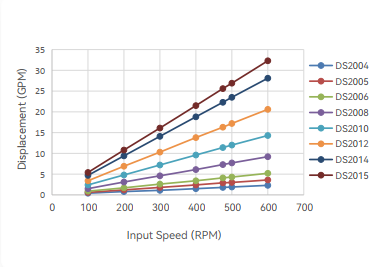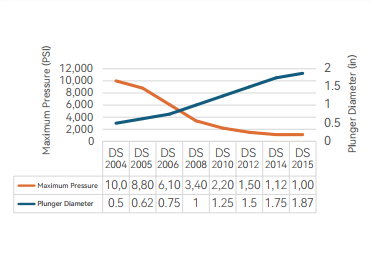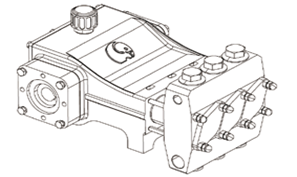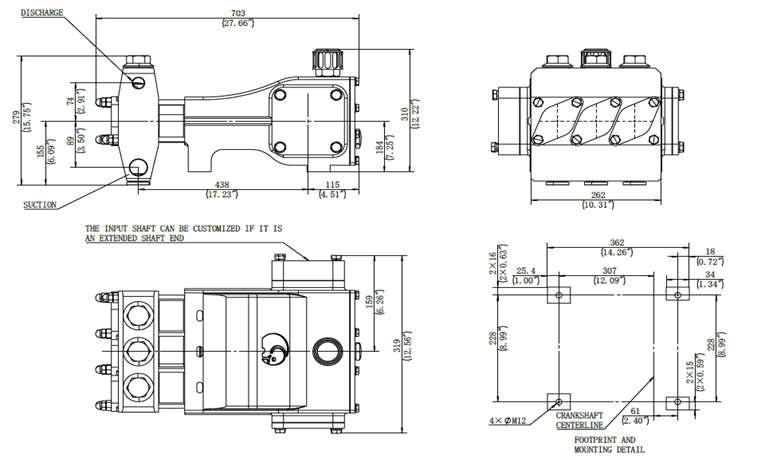نموذج :
DS-20يكتب :
Plunger Pumpسكتة دماغية :
1.5 Inches/38.1mmقطر الاسطوانة :
13-48mmتدفق :
1.5-122.3LPM/0.4-32.3GPMضغط :
7-69MPaميناء الشحن :
Shanghai Port, Chinaضمان :
12 MonthsSpecifications:
| Design Standard | API-674, Third Edition |
| Configuration | Horizontal Triplex Plunger |
| Number of Plungers | 3 |
| Continuous Duty | 16.6 BHP |
| Intermittent Duty | 20.9 BHP |
| Stroke Length | 1.5 Inches/38.1mm |
| Frame Load Rating | 2,700 lbs/1244.7kg |
| Pump Weight (Average) | 245 lbs/111.13kg |
| Intermittent Duty Speed Rating | 600 RPM |
| Continuous Duty Speed Rating | 475 RPM |
| Minimum Speed | 100 RPM |
| Mechanical Efficiency | 90% |
| Lubrication System | Splash, Gravity Return |
| Lubrication System (Optional) | Pressurized |
| Crankcase Oil Capacity | 2 Gallons/7.57L |
| Lube Oil Type | SAE 30 |
| Fluid Temperature Range | -20 to 350 °F /-28~176°C |
| Valve Type | Disc Valve / Wear-resistant Valve |
Performance Data (Metric):
| Pump Model |
Plunger Diameter (mm) |
Displacement (L/REV) |
Maximum Pressure (MPa) |
Pump Capacity (LPM)@Input Speed (RPM) | ||||||
| 100 | 200 | 300 | 400 | 475 | 500 | 600 | ||||
| DS2004 | 13 | 0.0144 | 69 | 1.5 | 3.0 | 4.2 | 5.7 | 6.8 | 7.2 | 8.7 |
| DS2005 | 16 | 0.0227 | 61 | 2.3 | 4.5 | 6.8 | 9.1 | 11.0 | 11.4 | 13.6 |
| DS2006 | 19 | 0.0326 | 42 | 3.4 | 6.4 | 9.8 | 12.9 | 15.5 | 16.3 | 19.7 |
| DS2008 | 25 | 0.0579 | 23 | 5.7 | 11.7 | 17.4 | 23.1 | 27.6 | 29.1 | 34.8 |
| DS2010 | 32 | 0.0905 | 15 | 9.1 | 18.2 | 27.3 | 36.3 | 43.1 | 45.4 | 54.1 |
| DS2012 | 38 | 0.1302 | 10 | 12.9 | 26.1 | 39.0 | 52.2 | 61.7 | 65.1 | 78.0 |
| DS2014 | 44 | 0.1775 | 8 | 17.8 | 35.6 | 53.4 | 71.2 | 84.4 | 88.9 | 106.4 |
| DS2015 | 48 | 0.2036 | 7 | 20.4 | 40.9 | 60.9 | 81.4 | 96.9 | 101.8 | 122.3 |
Performance Data:
| Pump Model |
Plunger Diameter (in) |
Displacement (GAL/REV) |
Maximum Pressure (PSI) |
Pump Capacity (GPM)@Input Speed (RPM) | ||||||
| 100 | 200 | 300 | 400 | 475 | 500 | 600 | ||||
| DS2004 | 0.5 | 0.0038 | 10,000 | 0.4 | 0.8 | 1.1 | 1.5 | 1.8 | 1.9 | 2.3 |
| DS2005 | 0.625 | 0.006 | 8,800 | 0.6 | 1.2 | 1.8 | 2.4 | 2.9 | 3 | 3.6 |
| DS2006 | 0.75 | 0.0086 | 6,100 | 0.9 | 1.7 | 2.6 | 3.4 | 4.1 | 4.3 | 5.2 |
| DS2008 | 1 | 0.0153 | 3,400 | 1.5 | 3.1 | 4.6 | 6.1 | 7.3 | 7.7 | 9.2 |
| DS2010 | 1.25 | 0.0239 | 2,200 | 2.4 | 4.8 | 7.2 | 9.6 | 11.4 | 12 | 14.3 |
| DS2012 | 1.5 | 0.0344 | 1,500 | 3.4 | 6.9 | 10.3 | 13.8 | 16.3 | 17.2 | 20.6 |
| DS2014 | 1.75 | 0.0469 | 1,120 | 4.7 | 9.4 | 14.1 | 18.8 | 22.3 | 23.5 | 28.1 |
| DS2015 | 1.875 | 0.0538 | 1,000 | 5.4 | 10.8 | 16.1 | 21.5 | 25.6 | 26.9 | 32.3 |
Standard connection sizes:
| Pump Model | Suction (in) | Discharge (in) |
| DS2004-DS2007 | 1.5 | 0.75 |
| DS2008-DS2015 | 1.5 | 1.0 |
| DS2008-DS2015 | 2.0 | 1.5 |
Fluid cylinder materials:
| Fluid cylinder materials | Cast |
| Carbon Steel | Ductile Iron |
| Fluid cylinder materials | |
| 304 / 316L / 17-4PH / 2205 / 2507 Stainless Steel |


Function
Chemical injection pumps play a vital role in industrial applications, primarily ensuring process stability and efficiency by precisely controlling the injection volume of chemical agents. These pumps adapt to diverse complex operating environments, delivering reliable performance in scenarios involving high pressure or corrosive media. Additionally, they offer flexible adjustment capabilities, enabling rapid modification of flow rates and pressures to meet specific application requirements. This flexibility not only enhances operational efficiency but also effectively reduces resource wastage, thereby lowering operational costs for users.
Engineering dimensional outline


In oil and gas extraction as well as chemical production processes, chemical injection pumps play a particularly crucial role. They deliver specific chemical agents with precision into the target medium to achieve corrosion prevention, scale inhibition, or fluid property enhancement. For instance, in oil and gas field development, these pumps can inject corrosion inhibitors or biocides into pipelines, thereby extending equipment lifespan and ensuring safe transportation. Their robust pressure resistance and stable operational performance make them ideal for extreme operating conditions. These advantages not only enhance overall system reliability but also provide strong support for sustainable industrial production.